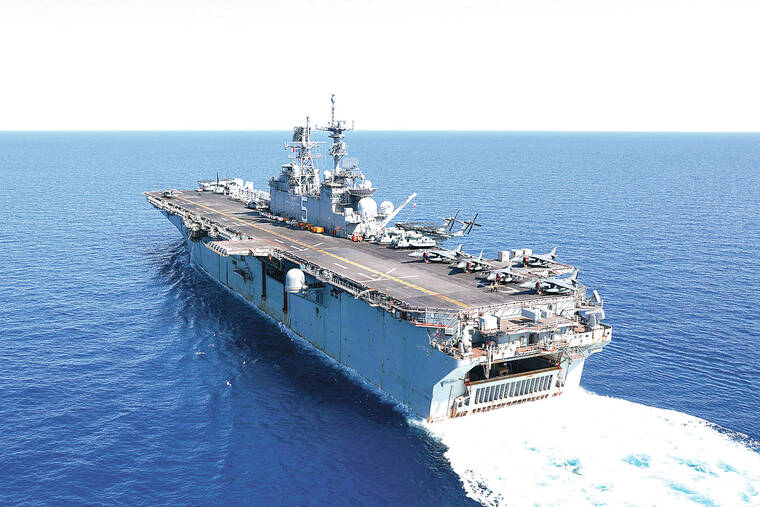Faced with evolving threats, US Navy struggles to change
PASCAGOULA, Miss. — A symphony of sorts echoed through the sprawling shipyard on the Gulf Coast of Mississippi — banging, hissing, beeping, horns, bells and whistles — as more than 7,000 workers hustled to fill orders fueled by the largest shipbuilding budget in the Navy’s history.
The surge in spending, $32 billion for this year alone, has allowed the Huntington Ingalls shipyard to hire thousands of additional people to assemble guided missile destroyers and amphibious transport ships. “More ships are always better,” said Kari Wilkinson, the president of the shipyard, pointing to the efficiencies that come with a steady flow of contracts and the jobs they create.
ADVERTISING
But the focus from Washington on producing a stream of new warships is also creating a fleet that some inside the Pentagon think is too wedded to outdated military strategies and that the Navy might not be able to afford to keep running in decades to come.
Half a world away, at a U.S. Navy outpost in Bahrain, a much smaller team was testing out a very different approach to the service’s 21st-century warfighting needs.
Bobbing in a small bay off the Persian Gulf was a collection of tiny unmanned vessels, prototypes for the kind of cheaper, easier-to-build and more mobile force that some officers and analysts of naval warfare said was already helping to contain Iran and could be essential to fighting a war in the Pacific.
Operating on a budget that was less than the cost of fuel for one of the Navy’s big ships, Navy personnel and contractors had pieced together drone boats, unmanned submersible vessels and aerial vehicles capable of monitoring and intercepting threats over hundreds of miles of the Persian Gulf, like Iranian fast boats looking to hijack oil tankers.
Now they are pleading for more money to help build on what they have learned.
“It’s an unbelievable capability — we have already tested it for something like 35,000 hours,” said Michael Brown, who was the director of the Defense Innovation Unit, which helped set up the unmanned drone tests in Bahrain. “So why are we not fielding that as fast as possible?”
The contrast between the approaches in Pascagoula and Bahrain helps to illustrate one of the biggest challenges facing the Navy.
At no moment since World War II has the service faced a more urgent demand to embrace new technologies and weapons systems, given the rising threat from a now formidable Chinese military.
The Navy’s top brass talks frequently about the need to innovate to address the threat presented by China. The Defense Department’s own war games show that the Navy’s big-ship platforms are increasingly vulnerable to attack.
But the Navy, analysts and current and former officials say, remains lashed to political and economic forces that have produced jobs-driven procurement policies that yield powerful but cumbersome warships that may not be ideally suited for the mission it is facing.
An aversion to risk-taking — and the breaking of traditions — mixed with a bravado and confidence in the power of the traditional fleet has severely hampered the Navy’s progress, several recently departed high-ranking Navy and Pentagon officials told The New York Times.
“The U.S. Navy is arrogant,” said Lorin Selby, who retired this summer as a rear admiral and the chief of naval research after a 36-year career in which he helped run many of the Navy’s major acquisition units. “We have an arrogance about, we’ve got these aircraft carriers, we’ve got these amazing submarines. We don’t know anything else. And that is just wrong.”
Resistance to risk-taking and change for the military can also be found among members of Congress.
Leadership on Pentagon budgets on Capitol Hill is dominated by lawmakers from shipbuilding communities like Sen. Roger Wicker, R-Miss. The industry directs tens of millions of dollars of campaign contributions to key lawmakers and mounts lobbying campaigns pushing the Navy to build more ships.
In just the past eight years, Congress has added $24 billion in extra money to build ships, more than any other part of the Pentagon budget, even as lawmakers have cut spending on repairs to the fleet, according to an analysis by the Center for Strategic and Budgetary Assessments.
Congress has also balked at efforts to retire older ships that the Navy says provide only marginal warfighting capacity, leaving the service at risk of not being able to afford basic maintenance and staffing costs.
The result, officials acknowledge, has been to bring into focus how slow the Navy has been to provide the funding and attention to the rapid innovation that many analysts say is necessary — even as money pours into conventional shipbuilding programs.


